Did reopenings work? What to do next? Surprising findings through Data Analysis
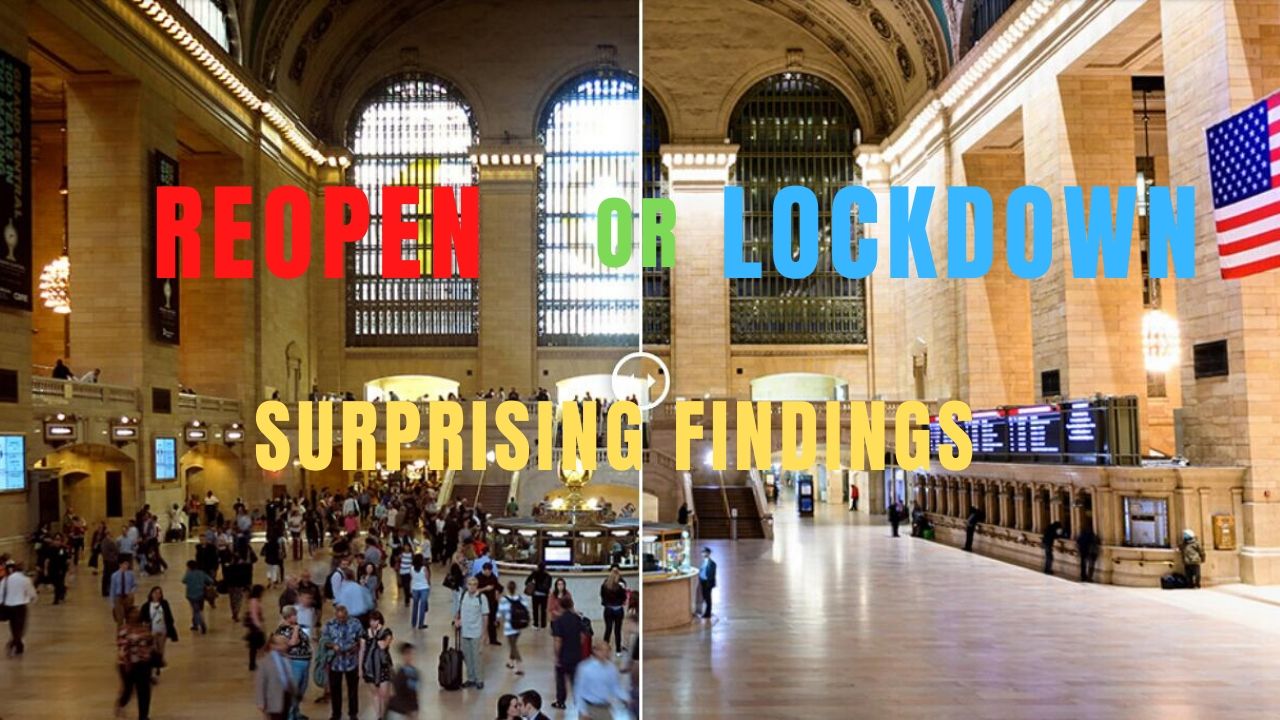
About
As states across America start to reopen, The big questions on everyone's mind are "Did the lock down work?
Did the my state make the correct decision to reopen?" This country is very divided on this issue. Since I was
asked by friend on my facebook to take a look at this purely from the data point of view, even though I initially
thought not enough time has passed for me to make any sense of whether reopening is hurting us yet or not, I wanted to
crack at this anyways, or at least get started on preparing the data so I can monitor it more closely and report
if and when I see things are beginning to go wrong. What I found surprised me. So I am sharing my findings here
and hopeful raise some awareness.
Numbers on this page are automatically updated daily.
6/20 Update: Reasons behind Recent Spikes (Is it due to testing?)
(Data source: covidtracking.com/api. This site povides daily compiled
updates including testing numbers for each state, which is cruical for the analysis in this section. Its data source
is also John Hopkins University data, but compiled in a easily queriable format that makes coding easier.)
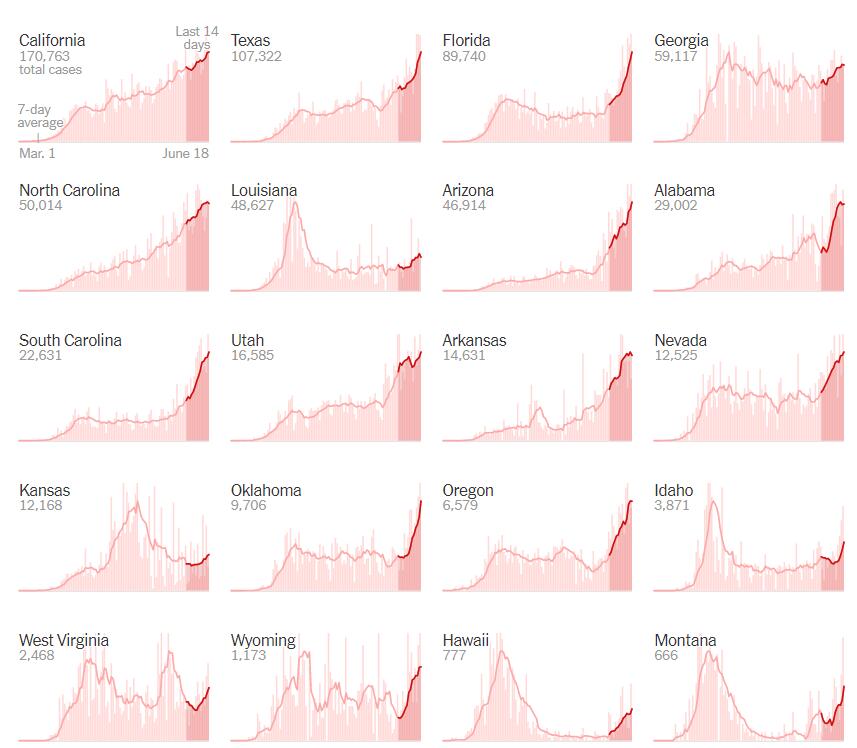 While everybody has their own view of how to interpretation of these plots: the left are saying "I told you so!",
and the right are depending with "nothing to see here, we are fine, these are just the results of increased
testing". Which is it? Well, let's continue to dig deeper into the numbers by incorporating the testing numbers
into the analysis....
While everybody has their own view of how to interpretation of these plots: the left are saying "I told you so!",
and the right are depending with "nothing to see here, we are fine, these are just the results of increased
testing". Which is it? Well, let's continue to dig deeper into the numbers by incorporating the testing numbers
into the analysis....
A month into reopening, multiple states are now seeing spikes in covid19 cases. Here is a quick view
of these states.

Where new cases are increasing
(source)
Let's first take a look at one of the new epicenters - Florida: the plot below shows how the testing
numbers (green dotted line is test numbers for that day, solid green line is the 3-day average of the
testing numbers) change over time. The grey line at the bottom is the daily new cases).
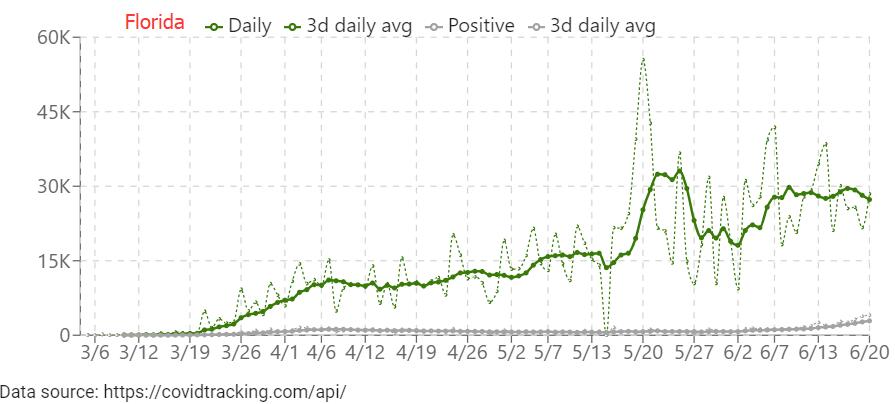 On first look, yes, indeed, the testing did indeed increased dramatically. Compared with April,
testing in May almost doubled, so it is not surprising that positive cases also increased?
On first look, yes, indeed, the testing did indeed increased dramatically. Compared with April,
testing in May almost doubled, so it is not surprising that positive cases also increased?
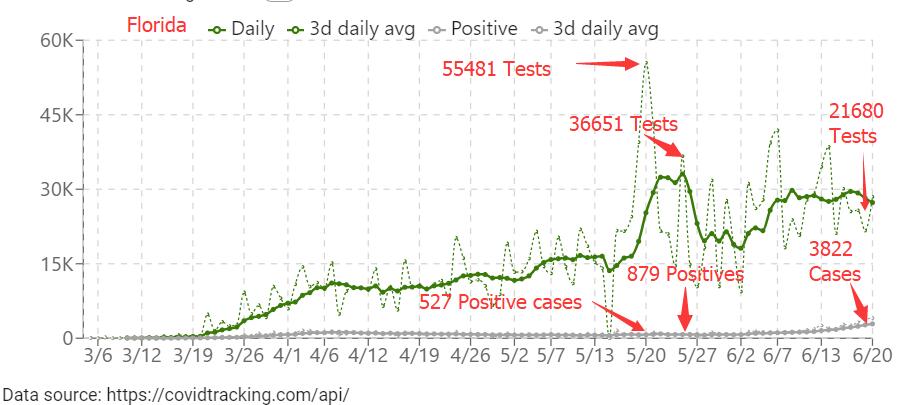 But wait a minute, upon a closer examination, we can see the testing dramatically increased around
5/20. If we look at the numbers around that time: 5/20 (55481 tests were performed, only 527 were tested
positive that day), 5/25 (36651 tests were performed, 879 positives), compared with
6/16 (30108 tests and 2783 positive cases) and 6/19 (21680 tests and 3822 positive cases).
It is now clear that the argument "the increased numbers are the result of increased testing"
does not hold true, at least for Florida.
But wait a minute, upon a closer examination, we can see the testing dramatically increased around
5/20. If we look at the numbers around that time: 5/20 (55481 tests were performed, only 527 were tested
positive that day), 5/25 (36651 tests were performed, 879 positives), compared with
6/16 (30108 tests and 2783 positive cases) and 6/19 (21680 tests and 3822 positive cases).
It is now clear that the argument "the increased numbers are the result of increased testing"
does not hold true, at least for Florida.


Let's take a look at another state - Texas:
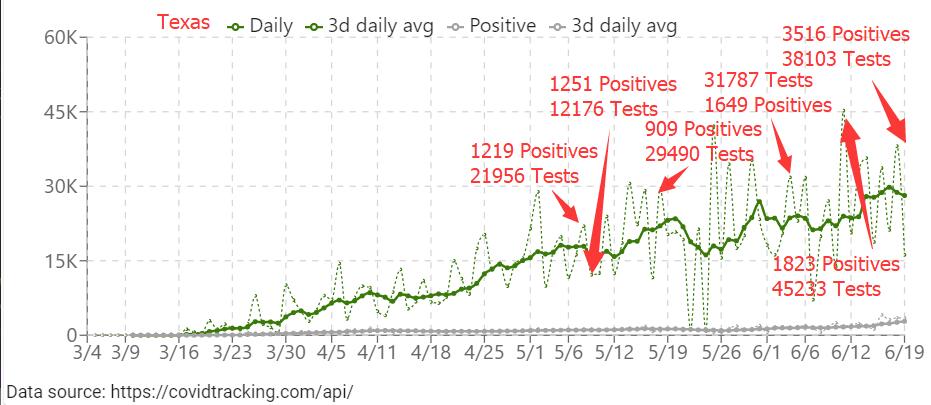 For Texas, the testing started to ramp up around 5/2 (28873 tests were performed and 1293 were positive),
5/8 (21956 tests and 1219) and 5/9 (12176 tests and 1251 positives), 5/18 (29490 tests and 909 positives).
These numbers should give you some idea that the number of tests performed does not quite correlate to
higher numbers.
As time continues, on 6/4 the number increased to around 1649 (while 31787 tests were performed),
on 6/11 it was 45233 tests and 1823 positive cases, and finally on 6/18 (38103 tests and 3516 cases).
For Texas, the testing started to ramp up around 5/2 (28873 tests were performed and 1293 were positive),
5/8 (21956 tests and 1219) and 5/9 (12176 tests and 1251 positives), 5/18 (29490 tests and 909 positives).
These numbers should give you some idea that the number of tests performed does not quite correlate to
higher numbers.
As time continues, on 6/4 the number increased to around 1649 (while 31787 tests were performed),
on 6/11 it was 45233 tests and 1823 positive cases, and finally on 6/18 (38103 tests and 3516 cases).

If we continue to apply the same analysis to the other states with numbers increase,
some are obvious that the positive case increases do not correlate to test increase, while others
are not so clear cut, take California for example
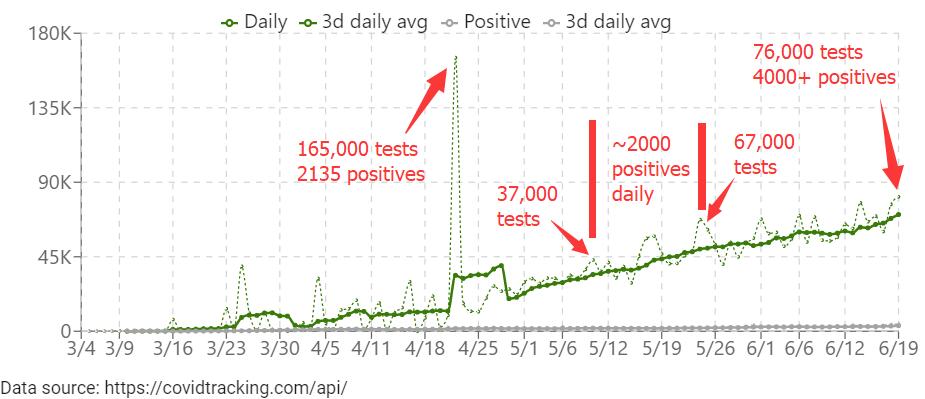 In California, there is an obvious ramp up in testing, that kind of correlate the increase in testing
with the increase in new cases. However, again when we take a closer look, we find that the correlation
also does not hold: between 5/9 to 5/24, the test numbers increased from 37K to 67K, and yet during that
period, the new cases fluctuated around 2000 (even on 4/23 when the tests massively increased to 165K, only
2135 new cases were found). Yet, on 6/18, we had 76K tests and resulted in 4000 positives.
One thing is clear from all these analysis: increased tests on most days do not equate to increased
in new positive cases. In other words, the correlation between increased test numbers and increase positive cases
simply isn't there.
In California, there is an obvious ramp up in testing, that kind of correlate the increase in testing
with the increase in new cases. However, again when we take a closer look, we find that the correlation
also does not hold: between 5/9 to 5/24, the test numbers increased from 37K to 67K, and yet during that
period, the new cases fluctuated around 2000 (even on 4/23 when the tests massively increased to 165K, only
2135 new cases were found). Yet, on 6/18, we had 76K tests and resulted in 4000 positives.
One thing is clear from all these analysis: increased tests on most days do not equate to increased
in new positive cases. In other words, the correlation between increased test numbers and increase positive cases
simply isn't there.

If there's any more doubt in the correlation, let's take a look at the numbers for New York and New Jersey.
We can clearly see that, for both of these states that were the epicenters of the US for covid19 for most of
April and May, have managed lowered the new cases dramatically, DESPITE increasing testing dramtically.
New York at its peak (on 4/9) has 10621 positive cases but only did 26,396 tests, compared to
on 6/19 they did 79,303 tests and only found 796 positive cases.
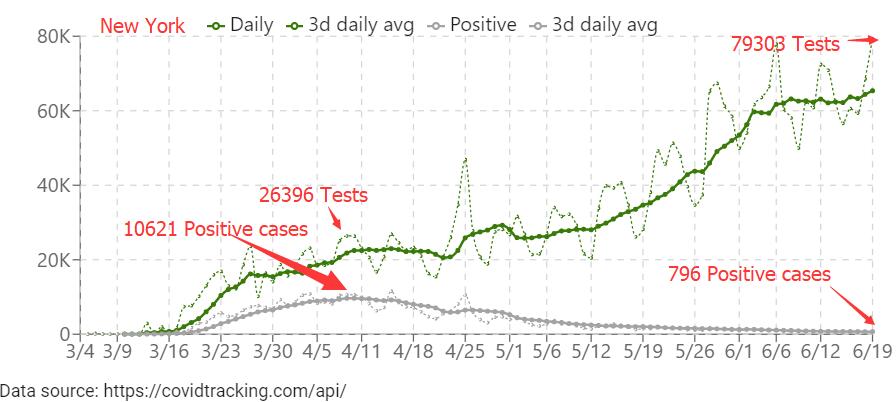 On the NJ side, the peak was on 4/23,
with 4124 cases over 8489 tests, compared with on 6/19, 22609 tests that found 389 cases.
On the NJ side, the peak was on 4/23,
with 4124 cases over 8489 tests, compared with on 6/19, 22609 tests that found 389 cases.
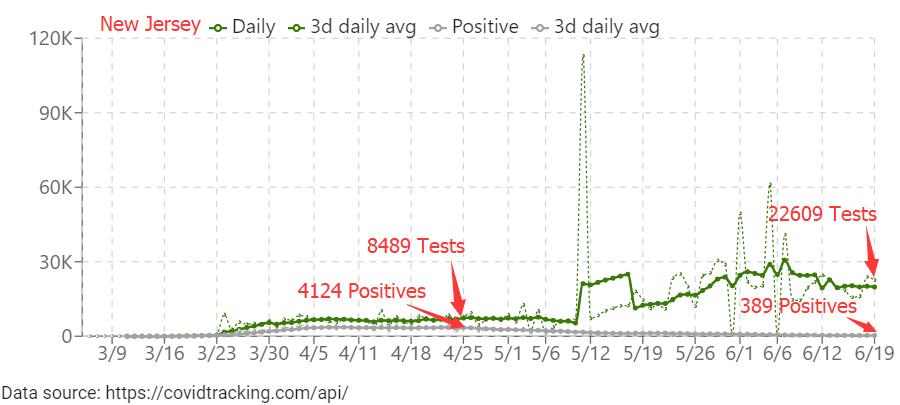


Conclusion
The logical conclusion is that the recent rise in numbers in the sunbelt states is the result of increased interaction introduced by reopening, and NOT due to increased testing.Why did some states spike while others did not?
Not all reopenings are created equal. The biggest variability is you, the people living there.
Since the basic principles for all reopening
are pretty much the same: keep your distance, stay away from crowds,
wear masks in public etc., it is all down how people like you and me behave under such
general guidelines. We now know that if the guidelines is followed, then we will keep seeing
the numbers flatten and continue to go down even after reopening, like in New York and New Jersey.
If you reopen and businesses do not follow the guidelines, e.g. allowing people sit too close,
allowing people not wearing masks to enter, then chances are you will see more spread in
those regions. The more populated a region is, the higher the chances a spread will occur.
It is becoming aparrent that since in this country, there will be no strict enforcement for people or businesses that do not follow the guidelines (because there are simply not enough law enforcement to do so), now it is quite easy to see who actually followed the guidelines (hint: the states with numbers spiking), and who did. Sure, state reopening plans matters, but only to the degree that the people actually follow and execute those plans.
For example, Georgia, is one of the states that reopened the earliest, and because of that a lot of initial reports focused on how people hung out in growded areas, and made it sound like things are going to be bad. Everybody was waiting for Georgia's numbers to spike. However, a later report indicated that despite the states aggressive reopening plans, most people remained apprehensive and did not rush to restaurants, bars and shopping malls as their government (and businesses) has hoped.
On the other end of the spectrum, let's take a look at California: it has the most strict lockdown/ reopening rules, its lockdown was the longest, it has some of wealthiest population in the world, so if any state can last the longest in a pandemic, it would be CA. Yet, surprisingly, CA's numbers never flattened, it just kept rising throughout the entire 3 months period, and now it has become one of the new epicenters in U.S. I asked around on in a large Facebook group as why, according to people living there, many in California actually did not follow the stay-at-home, no gathering, wear masks in public guidelines. So surprise, surprise....
It is becoming aparrent that since in this country, there will be no strict enforcement for people or businesses that do not follow the guidelines (because there are simply not enough law enforcement to do so), now it is quite easy to see who actually followed the guidelines (hint: the states with numbers spiking), and who did. Sure, state reopening plans matters, but only to the degree that the people actually follow and execute those plans.
For example, Georgia, is one of the states that reopened the earliest, and because of that a lot of initial reports focused on how people hung out in growded areas, and made it sound like things are going to be bad. Everybody was waiting for Georgia's numbers to spike. However, a later report indicated that despite the states aggressive reopening plans, most people remained apprehensive and did not rush to restaurants, bars and shopping malls as their government (and businesses) has hoped.
On the other end of the spectrum, let's take a look at California: it has the most strict lockdown/ reopening rules, its lockdown was the longest, it has some of wealthiest population in the world, so if any state can last the longest in a pandemic, it would be CA. Yet, surprisingly, CA's numbers never flattened, it just kept rising throughout the entire 3 months period, and now it has become one of the new epicenters in U.S. I asked around on in a large Facebook group as why, according to people living there, many in California actually did not follow the stay-at-home, no gathering, wear masks in public guidelines. So surprise, surprise....
Not all lockdowns/reopenings are created equal
According to stats from other countries, clearly lockdowns work. Here are a few countries and regions where
strict locked down strategy plus mass-testing and contact tracing have clearly worked for them. Here are
what their plots look like





Similarly, it has worked for a handful of states in the U.S., including



Notably, despite early false moves (delayed decision in initiating lockdown),
New York and New Jersey are the only few states where the numbers
are going in the right direction. Cearly what they did is working.
This is quite an achievement given New York was
and still is the epicenter of the U.S.


the following graphs and plots are generated using
data from New York Times
States lockdowns that failed and then recently worsened
Alabama
We can see in Alabama, the new cases number did not drop since mid-april, and
in Arizona, it actually continued to rise around the same rate even after lockdown
was implemented. Not surprisingly, in both cases, about a month into their respective
reopening, the number begins to rise quickly again. Most likely due to more restrictions
being lifted as well as people losing their sense of danger as more time passes.
Arizona
California, unfortunately is the poster-child of "lockdowns that did not work".
It stayed lockdown the longest, but its numbers just keep on rising.
Its strategies were sound, but unfortunately lots of people didn't follow them,
and now we can seeing the result.
California
North Caronlina, another new hotspot where lockdown didn't do anything.
North Carolina
States lockdowns that kind of worked, but now have a new wave
While in Texas, the post-reopen numbers seem to be increasing compared with the pre-reopen,
we can see that the numbers were already going up about a week prior to reopen, so it was already
heading in that direction anyways, regardless of whether the reopen order were instituded or not.
Although it seemed the situation may have stablized for a while after reopening, this is very normal due to
the delayed effect of the virus (asymptomatic period of upto 2 weeks) as well as the momentum
of stay-at-home and social distancing behavior, now we are seeing the reprecussions of the
increasing relaxing of the lockdown limitations. Now Texas is a new hotspot for covid19.
Texas
Florida, is another new epicenter that exhibits very similar spread pattern as Texas.
The spread seems to be picking up speed in the recent week. It is very worrisome.
Florida
The lockdown has flattened the new cases for both South Caronlina and Oklahoma,
but are not experiencing resurgence as in Florida. Even though not yet at Florida and Texas level yet.
South Carolina
Oklahoma
For Arkansas, the lockdown has clearly worked. But unfortunately, the reopening did not
go as planned. Not sure if it's the reopening plan was too aggressive or people didn't follow
guidelines, the end result is that we immediately saw an increase after reopening and now
the numbers jump kept rising.
Arkansas
Louisiana
Nevada
Oregon
Utah
States with stable numbers but still remain ticking timebombs
The daily new cases remain high. Even though if they are not going up YET,
there are still enough infected people in the population such that
one slip up (a super spreader getting into a crowded event, or just by attending
multiple small events) and we'll
have a new outbreak in our hands. Testing and contact tracing would play a
big part in preventing this.
Washington
Georgia
Iowa
Mississippi
Ohio
Numbers for other states
States with numbers heading in the right direction
New York
Pennsylvania
Connecticut
Massachusetts
District of Columbia
Illinois
Michigan
New Jersey
Maryland
Rhode Island
Nebraska
Vermont
Delaware
States worth looking into for reopening strategy
Here are a few states where the peak was observed near or after the
shelter-at-home order has been lifted, and then the numbers actually came down after reopening.
It is unclear what exactly caused the numbers to keep rising (one possibility is momentum),
and what allowed them to stay on course after reopening. They are worth looking into.
Colorado
Virginia
Minnesota
Wisconsin
North Dakota
Indiana
Kansas
States that are relatively safe due to lower numbers
These states have relatively low numbers and population density,
so even though so may have numbers on the rise,
I still consider them lower risk states compared to
other.
But people in these states still need to remain vigilent to avoid outbreaks.
Alaska
Hawaii
Idaho
Maine
Montana
New Hampshire
South Dakota
West Virginia
Wyoming
Puerto Rico
Why did lockdown/shelter-in-place worked for some states and not others?
I should first say for most of the states, the lockdown/shelter-in-place did work initially:
almost every one of the states, soon after the order were issued (take Wisconsin in the graph below for example),
we saw the new cases numbers flattening out
(instead of keep rising), and then the number began to drop. But somewhere in the middle of the
lockdown, something changed and the number began to rise again.
It's hard know exactly why without doing more detailed analysis on the behavior of people in
these states. Here are a few things I can deduct from the numbers using common sense and logic:
There are still many things we are not certain about, for example, how it spreads. There still
might be loopholes of infection that people might not be paying attentions to, even though
they might be following orders and staying home. This is just like initially,
many believed simply washing hands would enough to fight the outbreak. Even CDC recommended it, which
we now know is not true.
Due to the initial low infection rate in their local areas, many probably were skeptical of the
severity of the outbreak, but only heed to shelter-at-home rules because it's the law.
After a few weeks of obeying the law, and without actual law enforcement to enforce the rule, people most likely
would began to break away from the social distancing guidelines, causing numbers to rise
even though the state has not yet lifted the shelter-at-home order.
People who never believed in the severity of the outbreak and only saw it as media hype, they
might have carried to live normally, going to stores without masks, hanging out with family and
friends etc..
People became complacent because the numbers are falling and they think the worst is behind us.
As a result, they became careless with respect to following CDC guidelines of
social distance and personal hygene (hand washing).
People began to defy the shelter-at-home orders for many reasons: believe in misinformation,
political belief,
complacency, religious belief, strong belief in personal freedom, thinking the local government
are overracting to the outbreak and being too strict. All the protesting probably didn't help
keeping the numbers low. Wisconsin's famous protests only showed how fed the residents are
at the shelter-at-home order towards the end of the lockdown. There is a good chance many
have not been acting according to the guidance long before the protests began.
In some states there were many cases of outbreak in essential workers such in meat processing plants,
which brought the numbers up for
those states. This includes Iowa and Kentucky. More care needs to taken to prevent this from happening.
What to do moving forward?
I believe there are multiple ways to improve:
Learn from the best and follow what they do. So far what worked for countries that are winning
against the virus, they did several important things: lockdown, strict social distancing, wearing masks,
mass testing and contact tracing.
So far there are only a few states that seem to succeeding with their lockdown strategy, while others are failing.
Those that are failing and still wish to continue with the lockdown path should analyze how their lockdown differs
from the states that are winning. What rules are implemented to enforce the guidelines, how did the people
behave? Did they follow the guidelines or not? Doing the same thing will NOT get you out of the lockdown.
For the states that are reopening, having a strategy that taylored for the residents living in the states is the key. Don't treat the state homogeniously the same way. Find the hotspots that are contributing to the highest growth, and applying more aggressive enforcement strategies to those areas. Don't punish the areas that are doing well in social distancing and keeping their numbers down and have low risk of further outbreak. At the same time, implement contact tracing, make sure the ones that are tested positive are staying home and NOT running around making errands, especially not wearing protective gear.
Learn from failures and don't make the same mistakes again. Here are some major mistakes that are prevalent,
and were spread by you know who and you know what:
Covid-19 is just like the flu. FALSE
Attending large events and go to crowded places are OK, as long as you wash your hands is enough. FALSE
Covid-19 only affects the old and immunity impaired. FALSE
Wearing masks are useless. FALSE
There is no PPE shortage. FALSE. Even now there are a PPE shortages in some areas.
We are doing a great job on testing. FALSE
This is a political hoax. FALSE
This is a plandemic. FALSE
My freedom is more important than your health. FALSE. While freedom is important, in the face of pandemic, please be considerate
to those who are less healthy than you are.
For the states that are reopening, having a strategy that taylored for the residents living in the states is the key. Don't treat the state homogeniously the same way. Find the hotspots that are contributing to the highest growth, and applying more aggressive enforcement strategies to those areas. Don't punish the areas that are doing well in social distancing and keeping their numbers down and have low risk of further outbreak. At the same time, implement contact tracing, make sure the ones that are tested positive are staying home and NOT running around making errands, especially not wearing protective gear.
Lockdown or Reopen
While locking down properly would be the best measure to fight against the outbreak, however, given
the missteps at the early stages of the outbreak (testing kit shortage,
not locking down early enough, no strict enforcement
of the shelter-at-home orders, no mask wearing guidance till April), it would take much much longer
than other countries that won using the lockdown strategy. People need to put food on the table,
which means they have to work. Without a long term stimulus package, it is unlikely the lockdown
can keep going. So reopening is now an necessity. So people need to learn to deal with it. It is
important for the states and its people to realize that just because we are reopening, does not mean
we won, and everything can go back to normal. Currently the numbers are beginning to spike in some areas
that implemented the reopening. Nobody knows how to reopen safely yet, the reopening is only done
out of necessity, so everyone needs to be extremely careful. The same social distancing rules must apply.
Better testing and contact tracing strategies must be put in place. Otherwise, we are guaranteed to
see another spike in a few weeks.